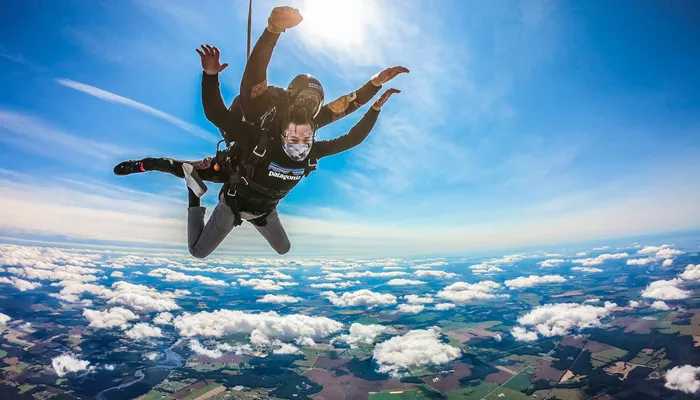Tandem skydiving is one of the most exhilarating experiences you can have, offering an incredible combination of thrill and a sense of freedom. As a beginner, one of the most common questions that people have before taking the plunge is about the speed at which they will fall. Skydiving is a unique experience that combines the beauty of freefall with the excitement of aerial views, but how fast do you really fall when you’re skydiving tandem?
Understanding the dynamics of a tandem skydive, including how fast you fall, can help prepare you for the experience. Let’s dive into the details of what affects your fall speed, how fast you’ll go during different stages of the jump, and why tandem skydiving feels as intense as it does.
Factors Affecting Your Fall Speed in Tandem Skydiving
The speed at which you fall while tandem skydiving is primarily influenced by several key factors: gravity, your body position, the weight of the tandem pair (you and your instructor), and air resistance.
The most significant factor that dictates your fall speed is the aerodynamic forces you encounter as you descend through the atmosphere.
1. Terminal Velocity
When skydiving, you’ll eventually reach what’s known as terminal velocity—the maximum speed you will fall due to air resistance counteracting gravity. In tandem skydiving, this typically happens after about 10-15 seconds of freefall. Terminal velocity for tandem skydivers is usually around 120 miles per hour (193 km/h).
At this speed, the forces of gravity and air resistance balance out, which means you can no longer accelerate faster. The body’s position and the weight of both the tandem pair play a role in determining how fast the fall will be.
2. Body Position
The way you position your body also affects your fall speed. In a typical tandem skydive, you’ll be in a belly-to-earth position, which presents a larger surface area to the air. This creates more air resistance and slightly reduces your fall speed compared to more streamlined body positions.
If you were to jump solo and assume a head-down position (which professional skydivers often do), you could fall much faster, sometimes exceeding 200 miles per hour. However, with tandem skydiving, the instructor will ensure that your body remains in a safe, stable position during the fall, keeping the speed at a manageable level.
3. Tandem Pair Weight
The combined weight of you and your instructor is another important factor. A heavier tandem pair will experience a slightly higher fall speed due to the increased gravitational pull. However, this difference is typically very minimal and doesn’t drastically change the overall experience. Safety is always a priority, so the instructor will adjust the descent to ensure you stay within a safe, controlled speed throughout the jump.
The Stages of A Tandem Skydive
1. The Initial Drop (0-10 seconds)
After the plane door opens and you exit, the initial feeling is one of rapid acceleration as you start to fall. For the first few seconds, your body is accelerating toward the Earth, but you’re still not at your terminal velocity. During this time, you may feel a rush of wind as you drop, but this stage is usually brief.
2. Reaching Terminal Velocity (10-15 seconds)
As you continue to fall, you’ll quickly approach your maximum speed.
This typically happens around 10-15 seconds into the jump when your body reaches terminal velocity. For tandem skydiving, this is around 120 miles per hour in the belly-to-earth position.
3. Parachute Deployment (1-2 minutes)
After approximately 60 seconds of freefall, the instructor will deploy the parachute. When the parachute opens, you’ll experience a sudden and significant deceleration. This is one of the most thrilling aspects of the jump, as you go from falling at over 100 mph to a much slower, more controlled descent.
Conclusion
When you go tandem skydiving, you’ll typically fall at a speed of around 120 miles per hour after reaching terminal velocity, which usually takes 10-15 seconds. This speed is influenced by factors such as body position, the combined weight of you and your instructor, and air resistance. Skydiving offers an unmatched adrenaline rush, and understanding how fast you fall can help make the experience even more exciting as you prepare for the jump of a lifetime. Whether it’s your first time or you’re a seasoned adventurer, knowing the dynamics of your fall ensures you can focus on enjoying the thrill of freefall in a safe, controlled environment.

